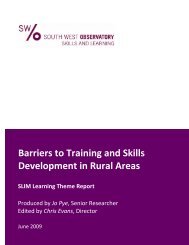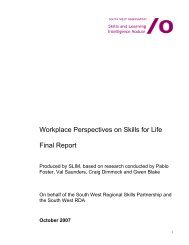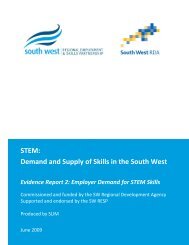Ageless at Work - Skills for Care
Ageless at Work - Skills for Care
Ageless at Work - Skills for Care
You also want an ePaper? Increase the reach of your titles
YUMPU automatically turns print PDFs into web optimized ePapers that Google loves.
These ‘entitlements’ or expect<strong>at</strong>ions are likely to result in a number of key changes in how the system<br />
and the work<strong>for</strong>ce ‘works’. These elements were identified by Waddilove (2004) as:<br />
Integr<strong>at</strong>ion of the health and social care sector<br />
Partnership working models, including Str<strong>at</strong>egic Service Delivery Partnerships<br />
Needs led services r<strong>at</strong>her than institution-led services<br />
User centrality as against the person being ‘service-ridden’ or ‘service driven’<br />
Transparency and ease of access<br />
Role slippage between professional groupings<br />
Role slippage between <strong>for</strong>mal and in<strong>for</strong>mal caring networks<br />
Shared, or <strong>at</strong> least cross-referenced, systems of inter-professional training and work<strong>for</strong>ce<br />
development<br />
De-professionalis<strong>at</strong>ion of some tasks<br />
Adoption of some industrial models and ‘comprehensive per<strong>for</strong>mance assessment’.<br />
Waddilove (2004) also identified a series of potential blocks and impediments to the construction of<br />
new roles and new reconfigured ways of working. These include cultural barriers between<br />
organis<strong>at</strong>ions and professional groupings with different systems of training, socialis<strong>at</strong>ion, value base,<br />
language and ideology. Success, it is identified, will depend:<br />
“on high level str<strong>at</strong>egic analysis coupled with a commitment to learning organis<strong>at</strong>ion principles<br />
and modes of learning. They also suggest th<strong>at</strong> organis<strong>at</strong>ions will need to build in mechanisms<br />
to address issues of shared concern, to problem solve and to plan jointly, learning from each<br />
other’s failures and successes. This will rely on a genuine ‘no blame’ culture and may need<br />
structural supports like action learning sets or quality circles”.<br />
Wh<strong>at</strong> are the priorities <strong>for</strong> action?<br />
Re<strong>for</strong>ming social care to achieve personalis<strong>at</strong>ion will require a huge cultural, trans<strong>for</strong>m<strong>at</strong>ional and<br />
transactional change in all parts of the adult social care system, the scale of which ‘should not be<br />
underestim<strong>at</strong>ed’ (Department <strong>for</strong> Health, 2008):<br />
“The Government has recognised th<strong>at</strong> to meet this goal, the system will need to undergo<br />
further significant redesign in process, practice and culture to ensure people have access to<br />
high quality in<strong>for</strong>m<strong>at</strong>ion and advice, appropri<strong>at</strong>e early interventions and can exercise choice<br />
and control over the services and support they need. It will also require investment in training<br />
and support <strong>for</strong> the work<strong>for</strong>ce to enable them to meet the challenges of this new way of<br />
working.”<br />
Department of Health, 2009<br />
A new str<strong>at</strong>egy <strong>for</strong> the adult social care work<strong>for</strong>ce <strong>Work</strong>ing to Put People First groups priorities <strong>for</strong><br />
work<strong>for</strong>ce development under six ‘key themes’ (Department <strong>for</strong> Health, 2009c):<br />
<br />
The leadership of local employers in work<strong>for</strong>ce planning, whether in the public, priv<strong>at</strong>e, or third<br />
sectors and of Directors of Adult Social Services in the str<strong>at</strong>egic work<strong>for</strong>ce commissioning role;<br />
<strong>Ageless</strong> <strong>at</strong> <strong>Work</strong>: Change workplace cultures, development skills. Good practice report 9








